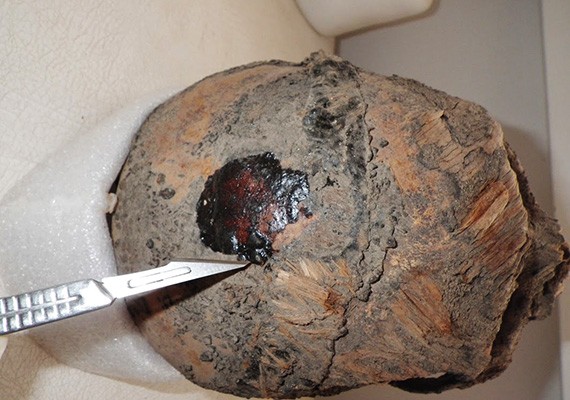Chinchorro Mummies Melting Into Black Ooze Because of Climate Change
| Ana Verayo | | Mar 10, 2015 09:03 AM EDT |
(Photo : Marcela Sepulveda/Harvard Gazette) The head of a Chinchorro mummy
Some of the world's oldest mummies that date back to 5050 B.C. are apparently beginning to degrade and rot and are emitting black ooze caused by global warming, according to researchers.
The study led by a Harvard team discovered this type of decay was detected across many ancient relics such as the walls of Tutankhamen's tomb and even Apollo mission space suits, but most especially in the Chinchorro mummies and other ancient, historical manuscripts.
Like Us on Facebook
This phenomenon was first observed among the 120 Chinchorro mummies housed in the archaeological museum of University of Tarapacá in Arica, Chile. Marcela Sepulveda, a professor of archaeology at the Archeometric Analysis and Research Laboratories of the University of Tarapacá, said this process has accelerated over the last decade.
Initial studies of samples from the museum revealed the degradation was caused by microbial sources. According to Ralph Mitchell from the Harvard School of Engineering and Applied Sciences (SEAS), microbial sources of decay are often described as opportunistic.
In microbiology, diseases often result from these sources since microbes reside in the body. These microbes saw an opportunity due to environmental changes.
Scientists have concluded the high moisture found in the air was slowly destroying the already fragile skin of the mummies. This was also consistent with what Sepulveda reported from the rising humidity levels in Africa.
Researchers also state the ideal humidity temperatures for mummies placed inside museums is between 40 percent to 60 percent. Anything higher than these ranges can lead to degradation and result in lower levels of acidification.
The 7,000 year-old Chinchorro mummies housed inside the museum aren't the only ones in existence. There are apparently hundreds more scattered beneath the surface of the region.
Scientists are now searching for better solutions to deal with this forensic problem as only the latest advances in science hold the key to the relics' longevity.
TagsChinchorro Mummies Melting Into Black Ooze Because of Climate Change, chinchorro mummies, Chile, mummies, Harvard, chinchorro mummies black ooze climate change, global warming
©2015 Chinatopix All rights reserved. Do not reproduce without permission
EDITOR'S PICKS
-

Did the Trump administration just announce plans for a trade war with ‘hostile’ China and Russia?
-

US Senate passes Taiwan travel bill slammed by China
-

As Yan Sihong’s family grieves, here are other Chinese students who went missing abroad. Some have never been found
-

Beijing blasts Western critics who ‘smear China’ with the term sharp power
-

China Envoy Seeks to Defuse Tensions With U.S. as a Trade War Brews
-

Singapore's Deputy PM Provides Bitcoin Vote of Confidence Amid China's Blanket Bans
-

China warns investors over risks in overseas virtual currency trading
-

Chinese government most trustworthy: survey
-

Kashima Antlers On Course For Back-To-Back Titles
MOST POPULAR
LATEST NEWS
Zhou Yongkang: China's Former Security Chief Sentenced to Life in Prison

China's former Chief of the Ministry of Public Security, Zhou Yongkang, has been given a life sentence after he was found guilty of abusing his office, bribery and deliberately ... Full Article
TRENDING STORY

China Pork Prices Expected to Stabilize As The Supplies Recover

Elephone P9000 Smartphone is now on Sale on Amazon India

There's a Big Chance Cliffhangers Won't Still Be Resolved When Grey's Anatomy Season 13 Returns

Supreme Court Ruled on Samsung vs Apple Dispute for Patent Infringement

Microsoft Surface Pro 5 Rumors and Release Date: What is the Latest?










